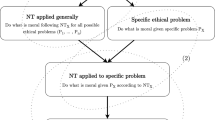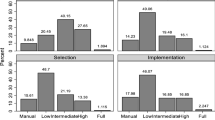Abstract
In this paper, we present a particular role for abductive reasoning in law by applying it in the context of an argumentation scheme for practical reasoning. We present a particular scheme, based on an established scheme for practical reasoning, that can be used to reason abductively about how an agent might have acted to reach a particular scenario, and the motivations for doing so. Plausibility here depends on a satisfactory explanation of why this particular agent followed these motivations in the particular situation. The scheme is given a formal grounding in terms of action-based alternating transition systems and we illustrate the approach with a running legal example.


Similar content being viewed by others
Notes
When speaking of persons we might call such a preference ‘character’ and may attempt to explain what kind of character the person has, cf. Walton (2007).
We use ‘non-abductive’ instead of ‘deductive’ because deductive implies that normal practical reasoning is not presumptive/defeasible, which, of course, it is.
Determining the audience given a VAF and an admissible set is computable in polynomial time (Bench-Copan 2007), so there are no complexity issues, even in large examples.
References
Alur R, Henzinger TA, Kupferman O (2002) Alternating-time temporal logic. ACM J 49(5):672–713
Atkinson K, Bench-Capon TJM (2007) Practical reasoning as presumptive argumentation using action based alternating transition systems. Artif Intell 171(10–15):855–874
Atkinson K, Bench-Capon TJM, McBurney P (2006) Computational representation of practical argument. Synthese 152(2):157–206
Bench-Capon TJM (2003) Persuasion in practical argument using value based argumentation frameworks. J Log Comput 13(3):429–48
Bench-Capon TJM, Doutre S, Dunne PE (2007) Audiences in argumentation frameworks. Artif Intell 171:42–71
Bex FJ, Prakken H, Verheij B (2006) Anchored narratives in reasoning about evidence. In: Legal Knowledge and Information Systems. JURIX 2006: The Nineteenth Annual Conference, IOS Press, pp 11–20
Bex FJ, Prakken H, Verheij B (2007) Formalising argumentative story-based analysis of evidence. In: Proceedings of the Eleventh International Conference on AI and Law (ICAIL 2007), pp 1–10
Dennett D (1979) Intentional systems. In: Brainstorms, Harvester Press, Sussex, pp 3–22
Dung PM (1995) On the acceptability of arguments and its fundamental role in nonmonotonic reasoning, logic programming and n-person games. Artif Intell 77:321–357
Leonard DP (2001) Character and motive in evidence law. Loyola of Los Angeles Law Rev 34:439–536
Modgil S (2006) Value based argumentation in hierarchical argumentation frameworks. In: Dunne PE, Bench-Capon TJM (eds) Computational Models of Argument, Proceedings of COMMA 2006, IOS Press, pp 297–308
Moses Y, Tennenholtz M (1995) Artificial social systems. Comput AI 14(6):533–562
Pennington N, Hastie R (1993) The story model for Juror decision making. In: Hastie R (ed) Inside the Juror, the psychology of Juror decision making. Cambridge University Press, Cambridge
Raz J (ed) (1978) Practical reasoning. Oxford University Press, Oxford
Thagard P (2004) Causal inference in legal decision making: explanatory coherence vs. bayesian networks. Appl Artif Intell 18:231–241
Wagenaar WA, Van Koppen PJ, Crombag HFM (1993) Anchored narratives: the psychology of criminal evidence. St. Martin’s Press, NY
Walton D (2007) Character evidence: an abductive theory. Springer, Berlin
Walton D, Schafer B (2006) Arthur, George and the mystery of the missing motive: towards a theory of evidentiary reasoning about motives. Int Comment Evid 4(2):1–47
Walton DN (1996) Argument schemes for presumptive reasoning. Lawrence Erlbaum Associates, Mahwah, NJ, USA
Wigmore John H (1931) The priinciples of Judicial proof. Little Brown and Company, Boston
Wooldridge M, van der Hoek W (2005) On obligations and normative ability: towards a logical analysis of the social contract. J Appl Log 3:396–420
Author information
Authors and Affiliations
Corresponding author
Rights and permissions
About this article
Cite this article
Bex, F., Bench-Capon, T. & Atkinson, K. Did he jump or was he pushed?. Artif Intell Law 17, 79–99 (2009). https://doi.org/10.1007/s10506-009-9074-z
Received:
Accepted:
Published:
Issue Date:
DOI: https://doi.org/10.1007/s10506-009-9074-z




